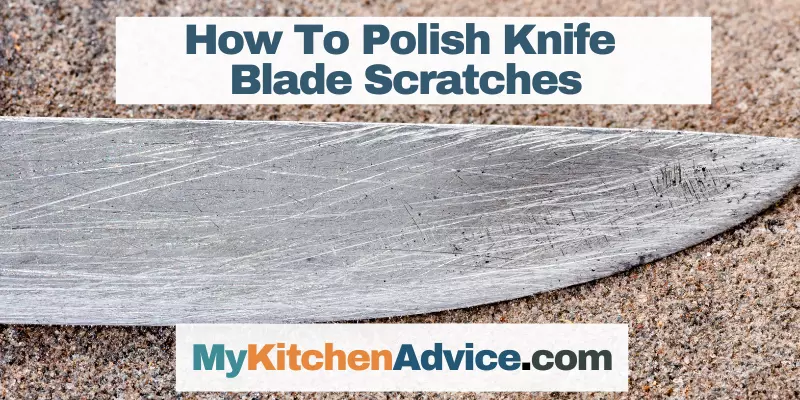A sharp and polished knife is an essential tool in any kitchen or workshop. However, over time, the blade may accumulate scratches from use or improper handling. Fortunately, with the right tools and techniques, it is possible to remove scratches and restore the blade to its former glory.
To polish knife blade scratches, start by cleaning the blade with soap and water, then use fine-grit sandpaper to gently rub out the scratches. Use a circular motion, and repeat the process with progressively finer grits. Finish with a buffing polishing cloth to restore the blade’s shine.
In this guide, we will discuss how to polish knife blade scratches effectively and efficiently, ensuring that your knife remains a reliable and functional tool for years to come.
5 Steps to Remove Surface Knife Blade Scratches: Easy Guide
Surface scratches are minor blemishes that only affect the top layer of the knife blade. The procedure is pretty easy to eliminate such marks as they are not deep. Here are the steps to remove them.
1. Clean the blade:
Before you start polishing the blade, make sure to clean it thoroughly with soap and water. Dry it completely to avoid water spots.
2. Apply a polishing compound:
Apply a small amount of polishing compound on the blade, making sure to cover the scratched area.
3. Rub the blade:
Using a soft cloth or microfiber towel, rub the blade in a circular motion. Apply gentle pressure, and keep rubbing until the scratches disappear.
4. Rinse and dry:
Rinse the blade with water to remove any leftover polishing compound. Dry it thoroughly with a clean towel.
5. Finish your work
Finish by coating the blade with a protective wax, oil, or compound. Apply with a brush and let it dry completely before use.
It’s important to note that these steps are only suitable for removing surface scratches. If the scratches are deeper, you will need to follow a different set of steps to remove them.
6 Steps to Remove Deep Knife Blade Scratches: Quick Steps
Deep scratches are more serious marks that penetrate the metal of the knife blade. It can take more effort to vanish them as they are deep into the metal. However, following the steps below can help you remove them.
1. Wash the blade:
Before you start with the procedure, start by washing the blade. This is done with soapy water ensuring the process goes smoothly and well. Make sure to dry it before going to the next step.
2. Sand the blade:
Use fine-grit sandpaper (around 600 grit) to sand the scratched area. Sanding smooths the layers to make the surface plain. Make sure to sand in the direction of the grain, and be gentle to avoid creating more scratches.
3. Apply a buffing compound:
Cover the scratched area on the blade with a small amount of a suitable buffing compound. This is the step before buffing the blade.
4. Use a buffing wheel:
Attach a buffing wheel to a power drill or bench grinder, and apply the wheel to the blade. Move the blade back and forth over the wheel, applying gentle pressure.
5. Wash and dry:
Wash the blade with water to clear any residues of the polishing compound. Dry it well with a clean towel.
6. Apply a protective layer:
After polishing, it is crucial to apply a protective layer. The coatings can be wax, oil, or synthetic compound to prevent further damage. It keeps the blade sharp.
Apply the layer on the knife with a brush or cloth and leave it to dry. Now you are good to go.
7 Ways To Avoid Knife Blade Scratches: Maintenance Tips
There are several using and maintenance tricks that can help you avoid knife scratches. Applying the knife appropriately and maintaining it keeps the knife shiny. Have a look at the best ways below.
1. Choose the Right Cutting Surface:
Use a cutting board that is softer than the knife blade, such as wood, bamboo, or plastic, to prevent scratching the blade.
2. Avoid Hard or Abrasive Materials:
Do not cut on hard surfaces like granite, metal, or ceramic, as they can quickly damage the knife blade.
3. Use Proper Cutting Technique:
Cut with a smooth, controlled motion and avoid chopping, hacking, or twisting the blade, which can cause scratches and chips.
4. Store Knives Properly:
Keep knives in a knife block or sheath to prevent them from coming into contact with other hard objects, which can lead to scratches and other damages.
5. Clean Knives Carefully:
Use a soft cloth or sponge to clean the blade gently, avoiding abrasive cleaners or scrubbers that can cause scratches.
6. Sharpen Knives Regularly:
A dull blade can cause more damage to food and increase the risk of accidental cuts, so ensure that you sharpen the knife regularly to maintain its edge.
7. Handle with Care:
Always handle knives with care and respect, and avoid dropping them or using them for unintended purposes that can cause scratches and other damages.
FAQs:
How Do I Determine The Depth Of The Knife Blade Scratches?
To determine the depth of scratches on a knife blade, visually inspect the blade and run your fingernail over the scratch. If it catches, it’s likely a deep scratch that will require more work to remove. If the scratch is shallow, it may be possible to remove it with a quick polish.
However, if it’s deep, you may need to spend more time and effort polishing the blade to remove the scratch completely. It’s important to properly assess the depth of the scratch to ensure you use the appropriate tools and techniques to restore the blade’s finish.
Is It Possible To Remove All Scratches From My Knife Blade?
Whether it’s possible to remove all scratches from a knife blade depends on the depth and severity of the scratches. Minor scratches can usually be removed with polishing, while deeper scratches may be more difficult or impossible to completely remove.
However, even if you can’t remove all scratches, polishing your blade can improve its appearance and performance. It’s important to note that removing too much metal while trying to remove scratches can also affect the blade’s edge and sharpness. So, it’s recommended to be careful and seek professional help if needed.
How Do I Know When I’ve Polished The Knife Blade Enough?
You’ll know that you’ve polished the blade enough when the scratches are no longer visible and the blade has a smooth and shiny surface. Take a close look at the blade under good lighting and at different angles to ensure that all scratches have been removed.
If you can still see scratches, continue polishing until they are no longer visible. It’s also important to avoid over-polishing, which can damage the blade and remove too much material, so be careful not to overdo it.
Which Polishing Compound Is The Best To Polish Knife Blade Scratches?
There are many types of polishing compounds that can be used to polish knife blade scratches, but the best one depends on the type of steel used in the blade. For example, if you have a high-carbon steel blade, you should use a compound that is specifically designed for high-carbon steel.
If you’re not sure which compound to use, it’s best to do some research on the type of steel your knife is made of and find a compound that is compatible with it. Some popular brands of knife polishing compounds include Flitz, Simichrome, and Mother’s Mag & Aluminum Polish.
Can You Buff Scratches Out Of A Knife Blade?
Yes, it is possible to buff scratches out of a knife using a polishing compound or abrasive and a polishing cloth or buffing wheel. The depth and severity of the scratches will determine the amount of effort and time required to remove them.
It’s important to use a polishing compound specifically designed for knives and to apply even pressure and work the compound into the scratches with a circular motion. With patience and effort, you can achieve a smooth and shiny finish on your knife blade.
Does Olive Oil Remove Knife Blade Scratches?
Olive oil is not an effective solution for removing knife blade scratches. While it can help to lubricate the blade and prevent future scratches, it does not have the abrasive properties needed to remove existing scratches.
Instead, specialized polishing compounds or abrasives should be used to remove scratches from knife blades. These products are designed to be gentle enough not to damage the blade, but abrasive enough to remove scratches and restore the blade’s shine. Using olive oil as a substitute for proper polishing materials could potentially damage the blade or leave it looking worse than before.
Can I Use Regular Metal Polish To Remove Scratches From My Knife Blade?
Using regular metal polish to remove scratches from your knife blade is not recommended. Regular metal polish is designed for less delicate surfaces and can be too abrasive for a knife blade, potentially causing further damage.
Instead, use a polishing compound specifically designed for knives. These compounds are formulated to be less abrasive and can effectively remove scratches without damaging the blade. It’s important to use the right products and techniques to ensure your knife remains in good condition and retains its sharpness.
How Often Should I Polish My Knife Blade?
It’s recommended to polish your knife blade whenever it becomes scratched or dull. This will help maintain its sharpness and extend its lifespan. The frequency of polishing will depend on how frequently you use your knife and the tasks it’s used for.
Knives used for heavy-duty tasks may need to be polished more often than those used for lighter tasks. Pay attention to the appearance and performance of your knife, and polish it as needed to keep it in top condition.
Conclusion:
In conclusion, polishing knife blade scratches can be a straightforward process that can restore the appearance and functionality of your knife. The key to successfully polishing out scratches is to start with a coarse grit abrasive and work your way up to a fine grit.
It’s important to take your time and not rush through the process to avoid further damage to the blade. Additionally, using the right tools and techniques can make a significant difference in the outcome. By following these steps, you can effectively remove scratches from your knife blade and keep it looking sharp and performing at its best.


